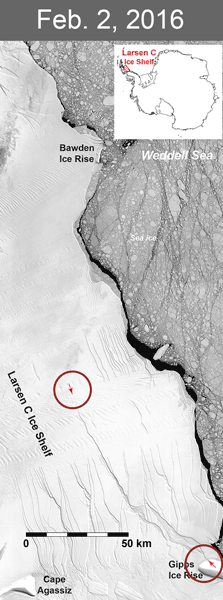A Delaware-sized iceberg has broken off of the Antarctic Peninsula
After months of close observation, a rift has created a massive iceberg out of the Larsen C ice shelf. The berg is about 2,240 square miles.
An iceberg bigger than the state of Delaware has snapped off of the West Antarctic ice shelf and is now floating in the Weddell Sea.
At roughly 600 feet tall, with a volume twice that of Lake Erie, it is one of the largest icebergs ever recorded.
“It is absolutely massive,” said Heidi Sevestre, a glaciologist who is part of a research team called Project MIDAS that has been monitoring the growing crack for years.

Watch the rift grow across the Larsen C. The rift reached the edge of the ice shelf sometime between Monday and Wednesday this week. (Source: Project MIDAS)
Over the past few months, “the rift kept on growing very, very quickly,” said Sevestre, “even though it’s winter [in Antarctica] right now.”
The calving occurred sometime between Monday and Wednesday, when thermal imaging from a NASA satellite revealed water surrounding the 2,200-square mile chunk of ice on all sides.
"The iceberg weighs more than a trillion [metric tons], but it was already floating before it calved away so has no immediate impact on sea level," the Project MIDAS research team wrote in a blog post.
With the calving, the Larsen C ice shelf lost more than 12 percent of its total surface area.
Calving may destabilize the rest of the shelf
Icebergs calving from Antarctica are a regular occurrence. But given its enormous size, the latest berg will be closely watched as it travels for any potential risk to shipping traffic.
Researchers expect it to remain in the Weddell Sea for some time, before drifting east and likely breaking apart into smaller pieces.
The calving may have heightened the risk of the remaining ice shelf disintegrating, the Project MIDAS team said.
Ice shelves extend from the coast of Antarctica and float on the sea. They act as giant dams, preventing land-based glaciers from flowing down from the mountains and directly into the ocean.
“Now what we are quite concerned about is how the ice shelf will react to the massive calving event,” said Heidi Sevestre, who is a research fellow at the University of St. Andrews in Scotland.
Computer modeling by the Project MIDAS team revealed a wide variety of potential outcomes after a calving event. Some models showed little change to the rest of the Larsen C ice shelf after the iceberg broke off. Others predicted the calving would dramatically destabilize the rest of the shelf.
“Worst-case scenario would be a collapse of the ice shelf,” Sevestre said.
If the glaciers held in check by Larsen C spilt into the Antarctic Ocean, it would lift the global water mark by about four inches, according to the AFP.

NASA satellites recorded the calving early Wednesday morning. In the image sequence above, the last images were taken during Antarctic night and use heat to detect the warmer water, shown in white, peaking through the rift as it grows. (Source: Christopher Shuman, NASA)
Iceberg not caused by climate change, but others have been
The calving of ice shelves occurs naturally, and Project MIDAS researchers say this cracking was the result of natural ice dynamics, not climate change.
It’s happening, though, against a backdrop of massive changes to the Antarctic continent that are due to global warming.
“What we’re observing today in many of the ice shelves around Antarctica is that they are indeed being impacted by climate change,” Sevestre said.
Warmer ocean water erodes the underbelly of the ice shelves, while rising air temperatures weaken them from above.
“Because these ice shelves are thinning more and more, these ice shelves are becoming more and more unstable, and eventually this might lead to collapses,” Sevestre said.
The nearby Larsen A ice shelf collapsed in 1995, and Larsen B dramatically broke up seven years later.
Those events were both linked to climate change, said Mark Serreze, director of the National Snow and Ice Data Center, in Boulder, Colorado.
“In some sense, the Antarctic ice sheet has been sort-of this sleeping elephant, but a sleeping elephant that is now beginning to stir like the rest of the globe is,” Serreze said.
Ice melt in Antarctica, Greenland and elsewhere around the globe is expected to contribute to up to six feet of projected sea level rise by the end of the century.
Related: Researchers continue to watch a massive rift in Antarctica likely to create a Delaware-sized iceberg
New technology allowed researchers to monitor this calving closely
The final break of the Larsen C ice shelf was detected by a NASA satellite called Aqua MODIS, which takes thermal images of the ground below.
The Project MIDAS team had been monitoring the progression of the crack with European satellites that use radar technology to “see” through cloud cover and the months-long darkness of the polar winter.
"We will continue to monitor both the impact of this calving event on the Larsen C ice shelf and the fate of this huge iceberg," said lead investigator Adrian Luckman, a professor at Swansea University in Wales.
"Some of the ice may remain in the area for decades, while parts of the iceberg may drift north into warmer waters," Luckman said.
The AFP contributed to this report.
